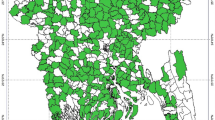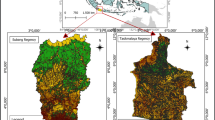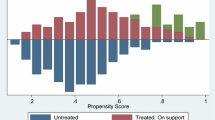Abstract
By using the propensity score matching method to control for differences in farmers’ characteristics, this research examines the impacts of organic rice farming on production performance in Cambodia. This chapter found that both the organic and conventional farmers can earn more rice income if they shift to organic rice farming. Organic farmers can receive a premium rice income of $US394–453/ha by shifting their farming practice, and conventional farmers would also get a higher rice income of $US468–508/ha if they shifted to organic farming. This chapter also found that only organic farming will result in higher rice income for conventional farmers because of the higher price of organic products. Therefore, this chapter strongly suggests that organic rice farming produces positive effects for farmers and that conventional farmers would benefit by shifting to organic farming. Farmers can get higher rice income if they conduct organic farming. To improve rice farming in Cambodia, organic rice cooperatives should help expand the market to obtain suitable prices and disseminate information to conventional farmers. NGOs and the Cambodian government should also support the cooperatives in expanding the market, provide extension services and guide subsistence farmers. The implementation of contract farming and farm insurance to secure production from organic farmers.
Access provided by Autonomous University of Puebla. Download chapter PDF
Similar content being viewed by others
1 Introduction
Agricultural modernization has resulted in a number of serious environmental problems over the past half-century, including water pollution and a reduction in biodiversity. To help solve these problems, it is important for the farming community to have a greater and clearer understanding of sustainable agriculture (Atsushi & Ping, 2010). Consequently, organic farming is gradually being promoted and practiced in many countries. Although organic rice farming has been introduced many years ago, Cambodia is certainly a latecomer to the international organic agriculture scene. Nevertheless, according to the Cambodian Organic Agriculture Association (2011), Cambodia has the potential to engage in organic rice farming, since many rice farmers have refused to fully embrace the intensive use of farm chemicals. In 2003, several Non-Governmental Organizations (NGOs), in conjunction with the Cambodian government, began promoting organic rice farming within farming communities. As a result, Cambodian small farmers were producing organic rice with notable success. However, in recent years, many farmers have returned to conventional farming because of certain constraints, such as the high labor input and price fluctuations in organic rice. Although some researchers have found organic rice farming to have a positive impact, some farmers are still skeptical about it because farmers tend to judge new technology based on their own needs and conditions before accepting it. Through a simple comparison, Taing (2008) observed that organic rice farming resulted in higher yields and income. However, according to Faltermeier and Abdulai (2009), using a simple comparison without controlling for differences in the characteristics of farmers can lead to a biased estimation. Hence, this chapter examines the impacts of organic rice farming on production performance in Cambodia by using the propensity score matching method to control for differences in farmers’ characteristics.
2 Methodology
This chapter employed a two-stage sampling technique. The first stage involves purposive sampling, in which three target cooperatives in three districts in Takeo and Kompot Provinces were selected. The second stage includes random sampling, in which organic farmers from cooperatives and conventional farmers were selected. Data were collected from face-to-face interviews conducted from March to April 2014. The interviews were based on structured questionnaires that focus on rice production during rainy season in 2013. In total, we interviewed 247 farmers, but only 221 respondents (84 organic farmers and 137 conventional farmers) were included in this chapter.
According to Faltermeier and Abdulai (2009), to accurately estimate the impact produced by the adoption of a new technology, farmers should randomly be assigned to either the adoption or non-adoption group. However, the farmers surveyed in this chapter decided on their own whether or not to adopt organic rice farming. Therefore, the impact of organic rice farming might be influenced by the farmers’ characteristics rather than by their organic farming practice. A simple comparison can thus lead to a biased estimation. Therefore, we employed the propensity score matching method to control for differences in farmers’ characteristics.
Propensity score matching is in two-step procedure (Becker & Ichino, 2002). The first step is to determine the farmers’ propensity scores by estimating the probability model (probit or logit), written as
where Y is a dependent variable (1 = Organic farmer; 0 = Conventional farmer), β is the regression coefficient to be estimated, and X is an independent variable to be explained.
Then, we estimated the propensity score based on the following equation:
In the second step, each farmer in the organic farming group is matched up to a conventional farmer with similar propensity score values to estimate the average treatment effect. Here, we used nearest neighbor matching (NNM) and kernel-based matching (KBM).
After matching, the balancing test is normally required to ascertain the quality of matching (Ali & Abdulai, 2010). We employed the mean absolute standardized bias (MASB) suggested by (Rosenbaum & Rubin, 1985), in which a standardized difference should be less than 20% to confirm success in the matching process. Additionally, to confirm the success of matching, Sianesi (2004) suggested that the pseudo R2 should be lower, and the joint significance of covariates should be rejected, after matching.
We used rice yield and rice income as outcome variables to evaluate the impact of organic rice farming. To control for differences in outcome variables in the propensity score matching, we included as farmers’ characteristics the age, gender (1 = male; 0 = female), and number of years of education of the household head, farming labor (number of laborers available for rice farming), house size (the square meters of the house owned by the farmer), the number of rice plots, total rice-field size, the farmer’s commercial status (1 = farmer sells his or her rice; 0 = otherwise), the number of cows owned by the farmer, the number of poultry owned by the farmer, tractor ownership (1 = farmer owns a two-wheel tractor, 0 = otherwise), other farm activities (1 = farmer engages in other farm activities, 0 = otherwise), off-farm activities (1 = farmer has an off-farm job, 0 = otherwise), and credit use (1 = farmer took out a loan; 0 = otherwise). We believe that the above variables are the main factors influencing production performance and the farmer’s decision to either adopt or reject organic rice farming practices.
3 Results and Discussion
3.1 Descriptive Results
Summary statistics and the results of the statistical significance tests for both groups are shown in Table 1. The level of the education of household’s head among the organic farmers group is statistically higher than that of the conventional farmers group, which suggests that farmers with a higher level of education are more likely to adopt new farming practices because information is more accessible to them and they are better adapting the new farming practice.
In addition, most organic farmers are large-scale commercial farmers, who own more plots and have larger rice fields compared to conventional farmers. Furthermore, 96% of organic rice farmers sold their rice, whereas only 69% of conventional farmers sold their surplus rice left over from their personal consumption. Compared to conventional rice farmers, the significantly higher percentage of organic farmers who engage in other activities, and who own two-wheel tractors as well as number of cows, clearly indicates that organic farmers are generally better than conventional farmers.
As shown in Table 1, organic requires more labor than conventional farming. Organic farmers spent 240.53 man-day/ha of family labor, which is significantly higher than the 198.82 man-day/ha spent by conventional farmers. No significant difference was found between two groups for rental labor. In total, organic farmers statistically contributed more labor than conventional farmers did, with a 45.49 man-day/ha difference, which shows that organic farming is labor-intensive. That might be one of the main reasons why some farmers refuse to adopt this farming.
Table 1 shows the production performance of organic farmers and conventional farmers. The yield, revenue, and total rice income generated by organic farmers is 0.75 t/ha, 460.70$/ha, and 597.90$/ha higher, respectively, than those produced by conventional farmers. Furthermore, the variable cost and total cost assumed by organic farmers are significantly lower than those assumed by conventional farmers because of the high amount of chemical fertilizers used in conventional farming, whereas the lower fixed cost of organic farmers is due to the larger rice-field size they own. From this simple comparison, we cannot conclude that organic farmers might have been influenced by their more favorable characteristics than by their adoption of organic farming. Therefore, controlling for those differences in characteristics is necessary in order to assess the impacts of organic farming.
3.2 Propensity Score Matching Results
The probit estimates of the adoption propensity equation are presented in Table 2. Several variables are significantly associated with the adoption of organic rice farming. Age, education, and commercial status are positively associated with the adoption of organic rice farming, which suggests that older farmers with a higher level of education are more likely to adopt new farming practices because information is more accessible for them, and they are better skilled at adapting new farming practices for commercial purposes. The probit model also shows that farmers who engage in other farm activities, who have more cows, and who own a tractor are likely to adopt organic rice farming because engaging in other farm activities and possessing a larger number of cows allow them to produce larger amounts of organic fertilizers for the organic farm. Moreover, possessing two-wheel tractors is favorable for conducting organic farming, which requires good land preparation. On the other hand, only house size is negatively associated with the adoption of organic farming. As an indicator of the farmer’s wealth, house size suggests that richer farmers are less likely to adopt organic farming, since they are interested in businesses other than rice farming.
Table 3 presents results from the covariate balancing tests before and after matching. The standardized mean difference for overall covariates used in the propensity score is 5.6–19% after matching. The p-values of the likelihood ratio tests indicate that the joint significance of covariates was consistently rejected after matching. The pseudo R2 also dropped significantly from 26.7% before matching to 1.5–8.3% after matching. The low pseudo R2, low mean standardized bias, and the insignificance of the likelihood ratio test after matching suggest that the proposed specification of the propensity score is fairly successful.
The impact of organic rice farming on production performance is shown in Table 4, which presents an assessment of organic rice farming by estimating the average treatment effect on the treated (ATT), the average treatment effect on the untreated (ATU), and the average treatment effect (ATE). Firstly, we examine the impact of organic rice farming on rice yield. Table 4 shows that for all matching methods, the difference in the ATT ranges from 0.38–0.55 t/ha with significant difference. It suggests that organic farmers received higher yields after they shifted to organic farming. Thus, organic farmers made the right decision by adopting organic rice farming because of their more favorable conditions, as discussed in the descriptive results. Table 4 also shows no significant differences among the four matching methods, except for five nearest neighbor matching in the ATU. Therefore, we don’t have enough evidence to conclude that conventional farmers will get higher yields if they shift to organic farming. However, it suggests that conventional farmers did not adopt organic farming because most of them are subsistence farmers who prefer to increase production for personal consumption rather than seek profit from organic farming, which would require a high amount of labor. Finally, the ATE shows that if all of the farmers in the sample shifted from conventional to organic farming, they would get higher yields ranging from 0.36–0.51 t/ha. This result confirms the finding of Taing (2008), who, using a simple comparison, concluded that organic farmers were able to obtain yields that are higher than those of conventional farmers.
We also examined rice income of both rice-farming practices to confirm the benefit of organic rice farming. The result shows a significant difference in the ATT and the ATU for all four matching methods. This strongly suggests that both the organic and conventional farmer samples can earn more rice income if they shift to organic rice farming. Organic farmers can receive a premium rice income of 394–453 $/ha by shifting their farming practice, and conventional farmers would also get higher rice income, ranging from 468–508 $/ha if they shifted to organic farming. This implies that conventional farmers made a wrong decision by not adopting organic rice farming. It is contradictory between rice yield and rice income which we do not have enough evidence to conclude that organic farming will result in higher yield for conventional farmers; however, organic farming will result in higher rice income for conventional farmers because of the price premium of organic rice. The result also reports the ATE, which suggests that if all of the sampled farmers shifted to organic farming, then rice income would increase by 439–487 $/ha for all matching methods. We found similar result in the works of Setboonsarng et al. (2008) and Mansoori et al. (2012), who concluded that organic rice farmers were able to obtain increased benefits, compared to conventional farmers.
4 Conclusion
The result of this chapter strongly suggest that organic rice farming produces positive effects for farmers and that conventional farmers would benefit by shifting to organic farming. Although we do not have enough evidence to support the conclusion that switching to organic rice farming results in higher yields for conventional farmers, the results of our study do show that farmers can derive higher rice income if they conduct organic farming.
Finally, since Cambodia has great potential in the organic rice industry, we recommend all stakeholders should work together to improve organic rice farming in Cambodia so that more benefits and opportunities may be derived from it. Organic rice cooperatives should help expand the market to obtain suitable prices and disseminate information to conventional farmers by enhancing own management system as well as the abilities of the cooperatives’ members. NGOs and the Cambodian government should also support the cooperatives in expanding the market, provide extension services, and locate technologies that can reduce the labor intensity of organic rice farming. Furthermore, all related institutions should guide subsistence farmers toward more commercially oriented practices and seek more investors to invest in organic rice trading. Lastly, to sustain the price of organic rice, we highly recommend the implementation of contract farming and farm insurance in order to secure production from organic farmers.
References
Ali, A., & Abdulai, A. (2010). The adoption of genetically modified cotton and poverty reduction in Pakistan. Journal of Agricultural Economics, 61(1), 175–192. https://doi.org/10.1111/j.1477-9552.2009.00227.x
Atsushi, M., & Ping, Y. (2010). Analysis of the social conditions conductive to sustainable organic rice farming around Lake Biwa in Japan. In L. L. Tolentino, L. D. Landicho, S. Wun’Gaeo, & K. Ikegami (Eds.), 4th Asian Rural Sociology Association International Conference (pp. 284–296). Asian Rural Sociology Association. https://www.academia.edu/3660461/4th_Asian_Rural_Sociology_Association_Conference_Proceedings
Becker, S. O., & Ichino, A. (2002). Estimation of average treatment effects based on propensity scores. The Stata Journal: Promoting Communications on Statistics and Stata, 2(4), 358–377. https://doi.org/10.1177/1536867x0200200403
Cambodian Organic Agriculture Association. (2011). Organic agriculture and food processing in Cambodia status and potentials. https://data.thailand.opendevelopmentmekong.net/en/library_record/organic-agriculture-and-food-processing-in-cambodia-status-and-potentials. Accessed date 10 Feb 2022.
Faltermeier, L., & Abdulai, A. (2009). The impact of water conservation and intensification technologies: Empirical evidence for rice farmers in Ghana. Agricultural Economics, 40(3), 365–379. https://doi.org/10.1111/j.1574-0862.2009.00383.x
Mansoori, H., Moghaddam, P. R., & Moradi, R. (2012). Energy budget and economic analysis in conventional and organic rice production systems and organic scenarios in the transition period in Iran. Frontiers in Energy, 6(4), 341–350. https://doi.org/10.1007/s11708-012-0206-x
Rosenbaum, P. R., & Rubin, D. B. (1985). Constructing a control group using multivariate matched sampling methods that incorporate the propensity score. American Statistician, 39(1), 33–38. https://doi.org/10.1080/00031305.1985.10479383
Setboonsarng, S., Stefan, A., Leung, P. S., & Cai, J. (2008). Profitability of organic agriculture in a transition economy: The case of organic contract rice farming in Lao PDR. In 16th IFOAM Organic World Congress. Modena, Italy.
Sianesi, B. (2004). An evaluation of the Swedish system of active labor market programs in the 1990s. Review of Economics and Statistics, 86(1), 133–155. https://doi.org/10.1162/003465304323023723
Taing, K. (2008). Economic analysis of organic-culture rice in rural household economy: Case studies in Tram Kork and Chumkiri District. Royal University of Agriculture.
Author information
Authors and Affiliations
Corresponding author
Editor information
Editors and Affiliations
Rights and permissions
Copyright information
© 2023 The Author(s), under exclusive license to Springer Nature Singapore Pte Ltd.
About this chapter
Cite this chapter
Khoy, R., Nanseki, T., Chomei, Y. (2023). Impacts of Organic Rice Farming on Production Performance in Cambodia: An Application of Propensity Score Matching. In: Nanseki, T. (eds) Agricultural Innovation in Asia. Springer, Singapore. https://doi.org/10.1007/978-981-19-9086-1_2
Download citation
DOI: https://doi.org/10.1007/978-981-19-9086-1_2
Published:
Publisher Name: Springer, Singapore
Print ISBN: 978-981-19-9085-4
Online ISBN: 978-981-19-9086-1
eBook Packages: Economics and FinanceEconomics and Finance (R0)




